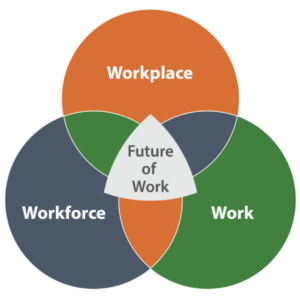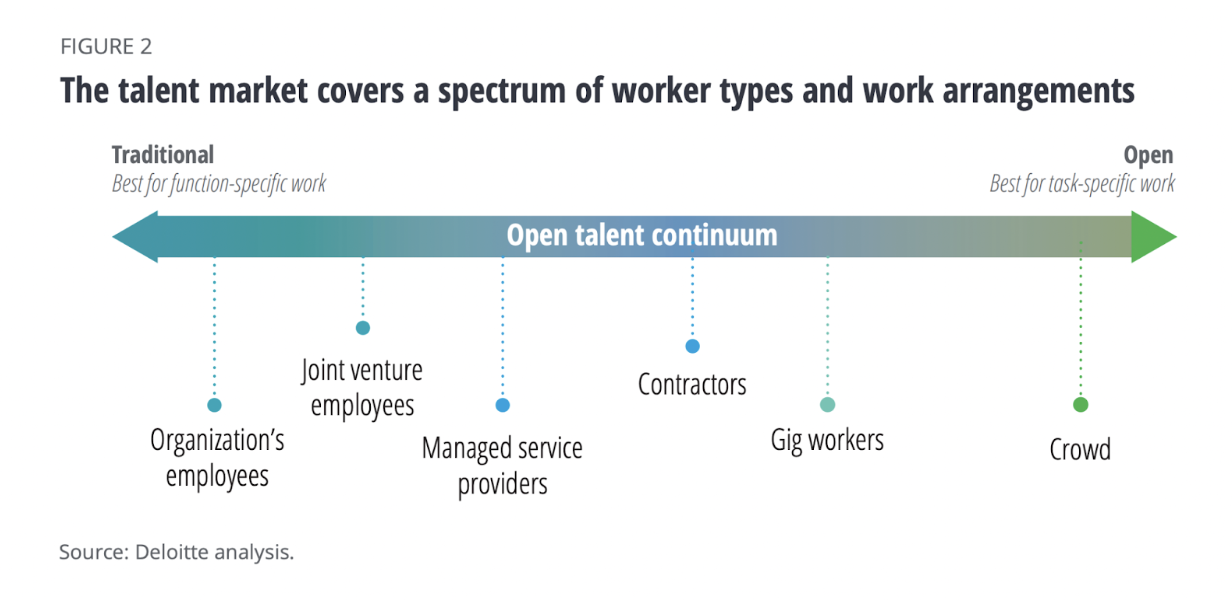What is the Future of Work? An Ultimate Guide

In a survey of 3,800 business leaders from around the world by Dell Technologies and Institute for the Future, 57% said their businesses are struggling to keep up with the pace of change.
But keeping up with major forces of change like automation and globalization is essential for businesses to be successful in the future. These forces of change will not only affect how work is done, but also who is doing the work and where and when it’s done. These three elements make up the concept of the future of work.
In this ultimate guide, we’ll explain what the future of work is, popular future of work trends, and more. Let’s dive in.
What is the future of work?
The future of work is a projection of fundamental changes to the workplace, the workforce, and the nature of work itself due to technological, generational, and social trends, like artificial intelligence, automation, and globalization.
Let’s break down the three major components of the future of work below.

The Work (The “What”)
This component focuses on what the actual work will be in the future. This “what” is transforming due to technological and cultural shifts.
For example, employees are increasingly relying on automation and artificial intelligence to get their work done more efficiently. This means that job responsibilities are expanding to include using analytic software, chatbots, and even robotics with the power to learn and adapt using AI, natural language processing, and machine learning. This also means that machines will free people from repeatable administrative and managerial tasks and give them more time to focus on problem-solving, communication, relationship management, and other areas that require human skills. This will fundamentally change our idea of work, which has historically been synonymous with task completion.
According to research from McKinsey & Company, the demand for technological skills has been growing since 2002 but it will accelerate in the 2016 to 2030 period. The increase in the need for social and emotional skills will similarly accelerate while the need for basic cognitive skills and physical and manual skills will decline.
In 2030, it’s estimated that the workforce will spend 55% more hours using technological skills and 24% using social and emotional skills than in 2016. On the other hand, hours spent using basic cognitive skills and physical and manual skills will decrease by 15% and 14% respectively.
Crises like the COVID-19 pandemic also led to fundamental changes in work. Skyrocketing demand for e-commerce and virtual transactions, including restaurant delivery, online grocery, online education, and telemedicine fundamentally shifted some people’s job responsibilities and scope.
The Workforce (The “Who”)
This component focuses on who is doing the work. The workforce has already shifted in the past few years, expanding beyond traditional full and part-time workers to include independent contractors, gig workers, and crowdsourced contributors. This trend is expected to continue in the future.
In a survey of more than 3,000 C-suite executives in seven countries (Canada, France, Germany, Italy, Spain, the United Kingdom, and the United States) by McKinsey & Company, 61% of respondents said they expect to hire more temporary employees.
While the composition of the workforce may change, the size will likely not change — despite the common misconception that robots will replace workers. About 77% of the respondents in the McKinsey & Company survey say they expect no net change in the size of their workforces in either Europe or the United States as a result of adopting automation and AI technologies. In fact, over 17% expect their workforces to grow. The jobs and skills of the workforce will shift though.
The workforce has also become increasingly hybrid, which means that many organizations have collocated workers as well as remote employees who live across the country or even the world. This increases the talent pool for employers but also introduces challenges of collaborating across time zones, complying with different countries’ laws and regulations, and creating an organizational culture that supports all workers.
Advances in technology and other forces of change will continue to reshape our ideas of a workforce — and how workers move into, within, and out of an organization.
The Workplace (The “Where” and “When”)
The shift toward increased workplace flexibility has been ongoing for decades, but it was significantly accelerated by the global coronavirus pandemic. In some industries, many workers can successfully work outside of an office or shared physical space. Of course, this is not true of all industries like retail and food services, but there has been a massive shift to remote work for industries like tech.
In a survey of 10,237 U.S. adults conducted in January 2022 by Pew Research Center, 60% of workers with jobs that can be done from home say when the coronavirus outbreak is over, they’d like to work from home all or most of the time if given the choice. This is up from 54% who said the same in 2020. Among workers who are currently working from home all or most of the time, 78% say they’d like to continue to do so after the pandemic. This is up from 64% in 2020.
In response to employees’ positive experiences with remote work, some companies are shifting to flexible workspaces. This will reduce the overall office space they need and bring fewer workers into offices every day. In fact, a survey of 278 executives by McKinsey found that they planned to reduce office space by 30% on average.
For the work that can be done anywhere in the world, it can also be done at any time. This disrupts the standard 9-5 workday. It’s even disrupting the traditional five-day week for some companies.
While what the workplace, workforce, and work will look like in the coming decades is hotly debated, business leaders agree that all three will radically change — as they already have since 2019. Below we’ll take a look at some predictions.
Future of Work Trends
In a survey by Gartner, human resources leaders said their number one priority was the future of work, followed by critical skills and competency development, organizational design and change management, employee experience, and current and future leadership.
To address this priority, HR leaders need to consider what the future of work might look like. Will it look like four-day weeks? A hard return to the office or a hybrid workforce? Then, they must assess which trends are most likely to impact their organization and figure out how to best prepare.
Let’s take a look at some of these predicted trends below.
1. Shortened Work Weeks
In this extremely competitive job market, some employers are increasing compensation to attract and retain talent. But some employers don’t have the financial resources to do so.
While keeping compensation flat, these employers are shortening the work week to four days. The reduced number of hours from 40 to 32 is even more attractive than compensation increases for some workers.
Redesigning work in this way is also tied to increased employee well-being and productivity. Perpetual Guardian, for example, was one of the first organizations to reduce its work week from five days to four. After reporting a 20% gain in employee productivity and a 45% increase in employee work-life balance after a trial period, the New Zealand trust management company made the policy permanent.
Microsoft Japan was another early adopter of this experiment to reduce its work week from five days to four. As a result of shortening the work week, Microsoft Japan reported a 40% increase in employee productivity as well as other benefits, like lower electricity costs.
2. More Employee Turnover
Another trend impacting the workforce will be increased and sustained employee turnover. This can be predicted for a few reasons.
One, hybrid and remote employees have weaker social and emotional connections with their coworkers, which make it easier for them to quit their job.
Two, the pool of potential employers will increase as hybrid and remote work options increase. The geographic radiuses of the organizations that employees can work for expand — or simply don’t apply — when they have the option to go into the office only once a week or not at all.
3. Requirements to Return to the Office
It’s expected that some high-profile companies will eventually demand that employees return full time to the office. These companies may implement a hard return to the office to try to recover organizational culture or explain away poor performance, among other factors.
The true reason for this mandate will be that these companies are struggling to manage a hybrid workforce. This decision will likely lead to more turnover as employees continue to view flexibility as a must-have rather than a nice-to-have.
4. Expanded Well-Being Initiatives
As wellness becomes an increasingly important metric for understanding employees, many companies will expand their wellness programs to include mental, physical, and financial health.
This will be spurred largely by the shift to working remotely. Some employees have become more sedentary. Some are more likely to become depressed. As a result, organizations will try to create more and better well-being programs that address the whole person.
This will prove to be a challenge, however. In the 2020 Deloitte Human Capital Trends survey, 80% of organizations said worker well-being is important or very important for their success over the next 12–18 months, but only 12% said they are “very ready” to address this issue.
5. Increased Transparency
The shift to remote work has also led to increased transparency, especially around information sharing. Many companies use applications like Trello and Asana to manage their work, and services like Google Drive to make this work accessible to team members to view or edit it at the same time or asynchronously. Companies are also using applications like Zoom and Loom to record meetings and trainings so employees can view them on their own time.
This is a significant improvement from when files were stored on employees’ computers without access permissions.
6. Broader Career Conversations
In the past, career conversations have focused on the specific next steps an employee could make based on their skill set. But in the future, managers should help their direct reports think more generally about potential roles and career paths that are based on their personal interests, experiences, and business growth opportunities.
Employees should also have career conversations with mentors in addition to their managers. Mentors can also help them identify and work toward development opportunities within the organization.
7. Alignment of Purpose and Passion
More and more employees will pick a job that is aligned with their passion and sense of purpose — not just for money. As a result, companies will try to attract employees not just with higher salaries but with an opportunity to make a meaningful impact.
That means their messaging will emphasize the company mission and how each employee’s work is tied to it. They may also create programs that encourage employees to share personal stories and experiences related to social causes.
8. Retraining
To build a future workforce, more companies will focus their talent strategy on retraining. Retraining involves teaching current employees new or different skills that the business needs. These skills will likely include advanced IT and programming skills and cognitive skills like critical thinking and problem-solving.
The advantage of retraining over hiring new employees is that the organization can preserve all the current employees’ knowledge, experience, and understanding of company culture as they upskill, instead of having to start from scratch.
To seize this advantage, some major organizations are investing large sums of money in retraining programs. Amazon, for example, pledged $700 million to retrain 100,000 employees — a third of its U.S. workforce — for higher-skilled jobs in technology over a period of six years. For example, some warehouse employees will be retrained to become basic data analysts.
9. Shift in Education
In the survey of more than 3,000 C-suite executives by McKinsey & Company, only 37% of respondents considered it important to build partnerships with educational institutions for effective retraining. 47% who planned to perform retraining internally.
While many companies share this isolationist attitude when it comes to retraining programs, universities, colleges, and other educators can help address the changing needs of the labor market. For example, higher-education institutions can expand their curriculums to include more data science and advanced technology courses.
10. More Coworking Spaces
As remote work becomes increasingly popular, so do challenges like communication, loneliness, and a lack of a sense of belonging. Employers with a hybrid or remote workforce are expected to increasingly use coworking spaces to help address these challenges. Coworking spaces also offer other benefits, including flexibility, networking, and increased productivity.
According to a study by Coworking Resources and Coworker.com, the number of coworking spaces worldwide is expected to more than double by 2024, surpassing 40,000.
How to Prepare for the Future of Work
While we don’t know exactly what the future of work will entail, we know it will become increasingly diversified, automated, and technology-enabled across all industries and verticals. Below are some tips for how leaders can help their organizations prepare for the future of work, whatever that may look like.
1. Create a flexible talent strategy.
It’s difficult for HR teams to plan for future talent needs when there’s so much uncertainty. To best prepare, these teams must create a talent strategy that can adapt and evolve with future requirements. The strategy should be informed by external labor market data, ongoing job analysis, and other trends.
For example, here are some questions to consider:
- What new and future-oriented positions are other organizations creating. An AI ethics specialist? An automation recruiter?
- How is work currently done and how could it be improved by technology?
- How can you retain talent beyond compensation? Flexible daily work hours? Shortened length of the work week?
2. Prioritize reskilling and upskilling.
Reskilling and upskilling must be prioritized to prepare your workforce for the future. Workforce training should shift away from physical and manual labor and basic cognitive skills, like basic data input. While this takes up a majority of employees’ time today, much of it will likely be automated by robotic process automation and related technologies in the future. So training should instead focus on helping employees develop their soft skills, like interpersonal relationship management and leadership, and technological skills like programming.
In some cases, the goal of training should not only be to make workers better in their current role — it should be to prepare them for a completely new role. Preparing and redeploying some workers into new roles or occupations is essential as some jobs are transformed or eliminated by technology and other forces of change.
The good news is companies won’t have to work hard for buy-in for this type of training. According to a survey of 10,000 people by PWC, 74% are ready to learn new skills or re-train to remain employable in the future.
3. Rethink your employment model.
There are dozens of employment models. The most traditional consists of full-time employees that work 9-to-5 jobs. There are other employment models that consist of full-time and part-time employees. These part-time employees may be seasonal or temporary until a specific project is complete.
The gig economy has introduced new employment models as well, mostly consisting of independent contractors or contingent workers.

Deloitte places these worker types on a spectrum according to whether they’re best for function-specific work or task-specific work.

To prepare for continued disruption in the workforce, you should look at other companies’ employment models and evaluate which is right for your organization.
For example, some organizations are replacing full-time employees with contingent workers to reduce costs or augment staff during labor shortages. While employing contingent workers does provide many advantages, it also presents challenges for onboarding, upskilling, performance evaluations, and benefits. You’ll have to weigh the pros and cons for your unique organization and HR department.
Predicting and Preparing for the Future of Work
In the past few years, we have witnessed fundamental changes to the workplace, the workforce, and the nature of work itself as a result of technological and social forces of change, like artificial intelligence, globalization, and the COVID-19 pandemic. In the future, we can expect even more changes.
The future of work presents organizations with countless challenges to adapt their culture, talent strategy, and workplaces — but also opportunities to make work more valuable and meaningful. Will you be prepared?